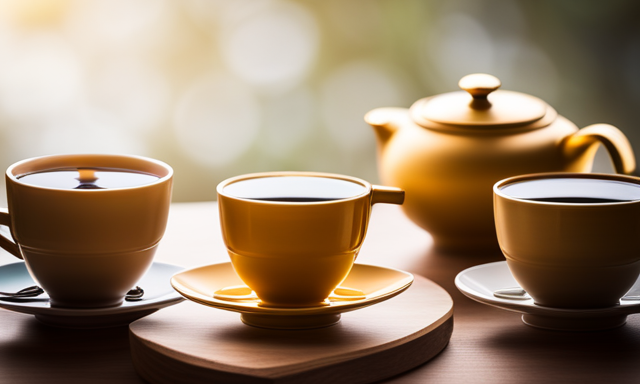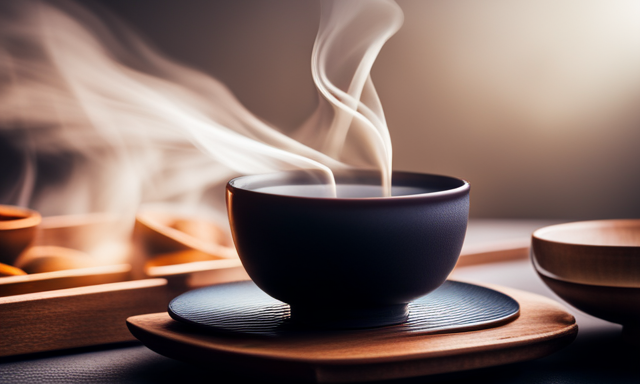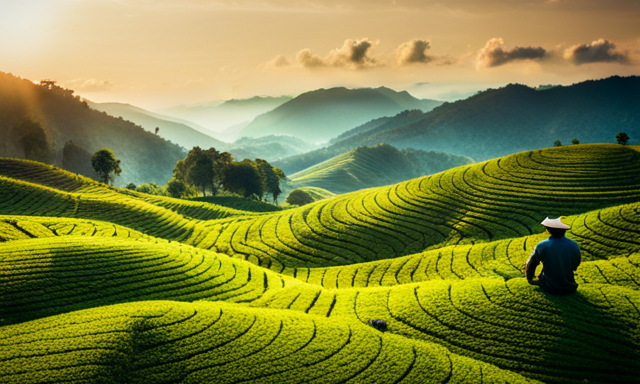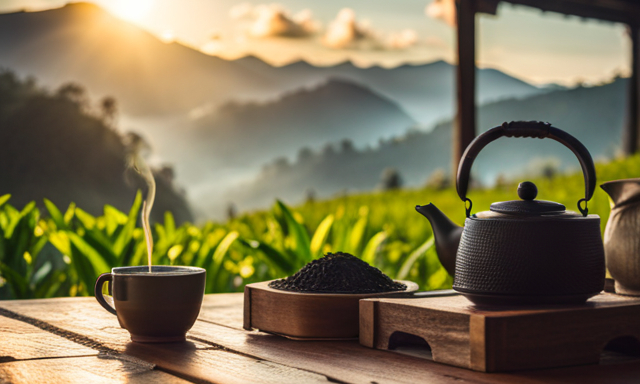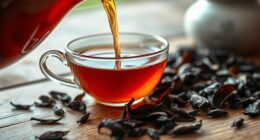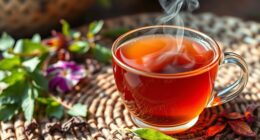As someone who loves tea, I am constantly amazed by the vast and varied universe of tea. Since my very first sip, I have been entranced by the complex flavors and delightful scents that different teas bring to the table. If you love tea as much as I do, you are in for a treat!
In particular, I have found myself drawn to black tea, green tea, and oolong. These three varieties of tea may all come from the same plant, but they each possess their own unique characteristics that set them apart.
In this article, we will explore the differences among black tea, green tea, and oolong, delving into their origins, flavor profiles, caffeine content, health benefits, and even their cultural significance.
So, grab your favorite teacup and join me on this journey as we dive into the wonderful world of black tea, green tea, and oolong.
Key Takeaways
- Black tea offers a robust and bold flavor, perfect for those seeking energy.
- Green tea has a light and delicate flavor, known for its antioxidant properties and calming effects.
- Oolong tea sits between black and green tea, offering a complex and nuanced flavor profile.
- Each tea has unique benefits and flavor profiles, so trying them all can help determine personal favorites and cater to individual taste preferences and wellness goals.
Introduction to Tea Types
If you’re wondering about the various types of tea, let me introduce you to the world of black tea, green tea, and oolong.
These three types of tea have their own unique flavors, aromas, and health benefits.
Different tea ceremonies around the world showcase the cultural significance of tea, from the intricate Japanese tea ceremony to the vibrant and social Moroccan tea ceremony.
Tea has also been known to have a positive impact on mental health, with its calming properties and ability to reduce stress.
Now, let’s delve into the origins of black tea, green tea, and oolong, and discover the fascinating stories behind these beloved teas.
The Origins of Black Tea, Green Tea, and Oolong
When it comes to tea, understanding the different processing methods is essential.
Black tea undergoes a full oxidation process, resulting in its robust flavor and dark color.
Green tea, on the other hand, is minimally processed. The leaves are steamed or pan-fried to retain their natural freshness and vibrant green color.
Lastly, oolong tea is partially oxidized, striking a balance between the flavors of black and green tea. It often exhibits complex and floral notes.
Processing Methods for Black Tea
One fascinating aspect of black tea is the unique processing methods that give it its distinctive flavor and color.
After the leaves are picked, they undergo a series of steps that include withering, rolling, fermentation, and drying techniques.
The withering process involves spreading the leaves out to dry, which reduces their moisture content.
This is followed by rolling the leaves to break down their cell walls, which releases the enzymes responsible for oxidation.
The leaves are then left to ferment, a crucial step that allows the tea to develop its characteristic flavor.
Lastly, the leaves are dried, which halts the fermentation process and preserves the tea’s flavor.
These processing methods result in the rich, dark color and bold flavor that black tea is known for.
Moving on to the processing methods for green tea…
Processing Methods for Green Tea
To make green tea, you’ll need to start by steaming or pan-frying the leaves, a process that helps to preserve their natural color and flavor. The traditional method involves steaming the leaves, which halts the oxidation process and gives the tea a fresh, grassy flavor. This method is commonly used in Japan to produce teas like Sencha and Matcha.
On the other hand, pan-frying is the preferred method in China, where the leaves are heated in a hot pan to stop oxidation. This method creates teas with a more roasted and nutty taste, such as Dragon Well and Gunpowder.
The choice between traditional and modern processing methods greatly impacts the flavor and aroma of green tea, offering a diverse range of tastes to explore.
Moving on to the next section about processing methods for oolong tea…
Processing Methods for Oolong
The unique and intricate processing methods of oolong tea result in a captivating range of flavors and aromas that tea enthusiasts can’t resist exploring. Oolong tea undergoes a partially fermented process, which sets it apart from both black and green tea.
After the leaves are plucked, they are spread out in the sun to wither and lose moisture. Then, the leaves are shaken or tossed in baskets to bruise the edges, which initiates the tea oxidation process. This partial fermentation is what gives oolong tea its distinct flavor and aroma.
The oxidation level of oolong tea can vary, resulting in a wide range of flavor profiles and aromas.
The subsequent section will delve into the delightful flavors and intoxicating aromas that oolong tea has to offer.
Flavor Profiles and Aromas
Contrasting their flavor profiles and aromas, black tea is robust and malty. Green tea, on the other hand, is fresh and grassy. Oolong tea strikes a harmonious balance between floral and earthy notes.
When it comes to flavor analysis, black tea has a strong and bold taste with hints of caramel and malt. It leaves a rich and lingering aftertaste that is often described as full-bodied.
On the other hand, green tea has a light and refreshing taste with a subtle vegetal note. Its aroma is often likened to freshly cut grass or steamed vegetables.
Oolong tea, with its unique processing method, offers a complex flavor profile that combines the best of both black and green teas. It has floral and fruity notes with a touch of earthiness. The aromatic experience of oolong tea is often described as captivating and soothing.
Overall, each tea offers a distinct sensory experience, making it enjoyable for tea enthusiasts to explore different flavor profiles.
Moving on to the next topic of caffeine content…
Caffeine Content
Black tea, green tea, and oolong tea all have varying levels of caffeine, providing a wide range of options to suit different energy needs. Caffeine is a natural stimulant that can have different effects on individuals. It is known to increase metabolism and promote fat oxidation, which may aid in weight management. However, it can also disrupt sleep quality if consumed in excessive amounts or close to bedtime. To help you understand the caffeine content in these teas, here is a table comparing the approximate caffeine levels in an 8 oz serving:
| Tea Type | Caffeine Content |
|---|---|
| Black Tea | 40-70 mg |
| Green Tea | 20-45 mg |
| Oolong Tea | 30-50 mg |
These values may vary depending on factors such as brewing time and water temperature. Now, let’s explore the health benefits of these teas and how they can positively impact your well-being.
Health Benefits
Green tea, with its array of health benefits, is like a soothing balm for the body and mind. Not only is it packed with antioxidants that fight off free radicals, but it also contains compounds that can promote heart health, improve brain function, and even aid in weight loss.
The catechins found in green tea have been shown to reduce the risk of certain types of cancer and lower cholesterol levels. Additionally, the L-theanine in green tea can help reduce anxiety and improve focus.
To fully enjoy these health benefits, it is important to brew green tea properly. The water temperature should be around 175°F, and the tea leaves should steep for about 2-3 minutes. This delicate brewing technique ensures that the tea releases its full potential before transitioning into the subsequent section about brewing techniques.
Brewing Techniques
Let’s delve into the art of brewing a perfect cup of tea, exploring the various techniques to enhance your tea-drinking experience.
The brewing temperature and steeping time are two crucial factors that determine the flavor and aroma of your tea.
Black tea is typically brewed at a higher temperature, around 212°F (100°C), for 3-5 minutes. This longer brewing time allows for a stronger, bolder flavor.
Green tea, on the other hand, requires a lower temperature of around 160-180°F (71-82°C) and a shorter steeping time of 2-3 minutes to prevent bitterness.
Oolong tea falls in between, with a brewing temperature of 190-200°F (88-93°C) and a steeping time of 3-4 minutes, resulting in a balanced and complex taste.
Now that we’ve explored the brewing techniques, let’s move on to the popular varieties and blends of these teas.
Popular Varieties and Blends
Now that we’ve covered the brewing techniques for black tea, green tea, and oolong, let’s delve into the world of popular varieties and blends.
There are endless options when it comes to tea, and each variety has its own unique characteristics. Here are some popular blends and their tea tasting notes:
-
Earl Grey: A classic blend of black tea with a hint of bergamot, offering a bold and citrusy flavor.
-
Jasmine Green Tea: Fragrant green tea infused with jasmine flowers, providing a delicate and floral taste.
-
Tie Guan Yin: A highly regarded oolong tea with a smooth and buttery texture, accompanied by floral and fruity notes.
-
Masala Chai: A traditional Indian blend of black tea, spices, and milk, creating a warming and aromatic experience.
These blends offer a wide range of flavors to suit different preferences.
As we explore the cultural significance of these teas, we’ll discover their rich histories and rituals.
Cultural Significance
Tea, with its deep-rooted cultural significance, serves as a symbol of tradition and connection in various societies around the world. Cultural traditions surrounding tea vary greatly, with each region having its own unique practices and rituals.
For example, in China, tea is an integral part of everyday life and is often used in social gatherings and ceremonies. The historical significance of tea in China can be traced back thousands of years, where it was used for medicinal purposes before evolving into a beverage enjoyed by all.
Similarly, in Japan, the tea ceremony holds great importance and is seen as a way to connect with nature and achieve inner peace.
These cultural traditions and historical significance highlight the profound impact that tea has had on different societies.
Moving on to the next section, pairing tea with food…
Pairing Tea with Food
When it comes to pairing tea with food, I find that black tea has complementary flavors that go well with rich and savory dishes, such as chocolate or roasted meats.
Green tea, on the other hand, is best enjoyed with light and delicate foods like sushi or steamed vegetables, as it helps to cleanse the palate.
Lastly, oolong tea is a versatile option that can enhance the flavors of a wide range of foods, whether it’s a spicy dish or a sweet dessert.
Complementary Food Pairings for Black Tea
Discover the perfect food pairings that will enhance your black tea experience and tickle your taste buds. When it comes to complementary food pairings for black tea, it’s all about finding flavors that complement and enhance the rich and bold flavor profile of black tea. Here are three delicious options to try:
-
Dark chocolate: The deep, slightly bitter notes of dark chocolate pair perfectly with the robustness of black tea, creating a harmonious blend of flavors.
-
Cheese: Whether it’s a sharp cheddar or a creamy brie, cheese brings a savory element that balances the boldness of black tea. Try pairing a strong black tea with a tangy blue cheese for a delightful combination.
-
Spicy foods: The heat from spicy foods, like curry or chili, can be balanced by the tannins in black tea. The result is a tantalizing contrast of flavors that will leave your taste buds wanting more.
Now, let’s move on to recommended food pairings for green tea.
Recommended Food Pairings for Green Tea
Green tea pairs well with a variety of light and delicate dishes, such as fresh salads or steamed fish, enhancing the subtle flavors in each bite. It is also a great accompaniment to desserts, particularly those with fruity or floral flavors. The light and refreshing taste of green tea complements sweetness without overpowering it.
Green tea has numerous health benefits, as it is rich in antioxidants that can help boost metabolism, improve brain function, and reduce the risk of certain diseases. It is also known to promote weight loss and improve heart health.
Now, let’s explore how oolong tea enhances flavors in a different way, shall we?
Enhancing Flavors with Oolong Tea
Oolong tea, with its unique flavor profile, has the ability to enhance the taste of various dishes and desserts. When exploring oolong tea flavors, you’ll discover a wide range of options that can complement different types of cuisines.
One popular way to incorporate oolong tea into desserts is by infusing it into creams, custards, or ice creams. The floral and fruity notes of oolong tea can add a delightful complexity to these sweet treats.
Additionally, oolong tea can be used as a marinade for meats, providing a subtle smokiness and enhancing the savory flavors. Its versatility allows you to experiment and find the perfect pairing for your desired taste.
In conclusion, oolong tea offers a unique flavor experience that can elevate both sweet and savory dishes, making it a versatile choice for enhancing flavors.
Conclusion and Recommendations
To fully appreciate the distinct flavors and health benefits of black tea, green tea, and oolong, you should explore their unique characteristics and determine which suits your taste preferences and wellness goals.
Black tea, known for its robust and bold flavor, is a great choice for those who enjoy a stronger taste and are looking for a boost of energy.
Green tea, on the other hand, is lighter and more delicate, with a slightly grassy and vegetal flavor. It is renowned for its antioxidant properties and is often chosen for its calming and detoxifying effects.
Oolong tea sits somewhere in between, with a complex and nuanced flavor profile that can range from floral to fruity. It is a versatile tea that can be enjoyed throughout the day.
In conclusion, each tea offers its own unique benefits and flavor profiles, so I recommend trying them all to find your personal favorite.
Frequently Asked Questions
How long should black tea, green tea, and oolong be steeped for optimal flavor?
To bring out the optimal flavor in black tea, green tea, and oolong, steeping techniques vary. Black tea should steep for 3-5 minutes, green tea for 2-3 minutes, and oolong for 3-7 minutes. The longer the steep, the stronger the flavor.
Can black tea, green tea, and oolong be consumed cold?
Yes, black tea, green tea, and oolong can be enjoyed cold. Cold brewing methods for these teas involve steeping them in cold water for several hours, resulting in unique flavor variations.
Are there any specific health risks associated with consuming black tea, green tea, or oolong?
There are no specific health risks associated with consuming black tea, green tea, or oolong. In fact, they offer numerous health benefits such as antioxidants and potential cancer prevention. The caffeine content varies among the three teas.
Are there any specific cultural rituals or traditions associated with the consumption of black tea, green tea, or oolong?
Cultural significance is found in the tea ceremonies associated with black tea, green tea, and oolong. These ceremonies vary by region but share a common focus on mindfulness, tranquility, and the appreciation of nature.
Can black tea, green tea, and oolong be blended together to create a unique flavor profile?
Blending possibilities with black tea, green tea, and oolong are endless, allowing for flavor experiments that can result in a unique flavor profile. One interesting statistic is that oolong tea is the most versatile for blending due to its diverse flavor profiles.
Conclusion
Well, after diving deep into the world of black tea, green tea, and oolong, I must say, what a journey it has been! These three teas may seem similar, but trust me, they are as different as night and day.
From their origins to flavor profiles, caffeine content, and health benefits, each tea has its own unique qualities.
So, next time you sit down for a cuppa, remember, your choice of tea says a lot about you – whether you’re a bold black tea lover, a zen green tea enthusiast, or a sophisticated oolong connoisseur.
Cheers to the wonderful world of tea!

